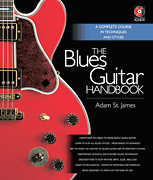Blog Archives
The History of Blues Sees No (Word) Limit, According to Adam St. James
Guest blogger and author of The Blues Guitar Handbook: A Complete Course in Techniques and Styles Adam St. James describes his experience while writing his newest book.
When I was writing my new book, The Blues Guitar Handbook, for publisher Backbeat Books, one of the coolest parts was the lengthy “History of Blues Guitar” at the beginning of book. They had asked me to write about 5,000 words, but I really had fun researching and writing this history, and instead I gave them 20,000 words, for a 50-page blues guitar history. The publisher laid out the material with some great vintage, rare, and in some cases, full color photos.
Here is a little excerpt:
Chapter I: A Historical Overview of Blues Guitar
The history of blues guitar is almost synonymous with the modern history of the guitar itself. Beginning in the early 1900s, blues guitar players laid the foundation for nearly every style of guitar playing to follow. Jazz guitarists, country guitarists, and of course rock guitarists – all owe a huge debt of gratitude to the original blues pioneers of the early 20th century. It was these players – colorful characters such as Robert Johnson, Blind Lemon Jefferson, and Son House – who brought not only their musical genre, but the instrument itself, to the forefront of popular attention and admiration.
In the earliest days of the recording industry, blues recordings often sold as many as a million copies, and blues performers became widely known to the general public. In addition to the heartfelt, sometimes aching, and regularly joyous vocals early performers committed to disc, it was the driving rhythms and plaintive cry of the blues guitar that captured the hearts and minds of would-be musicians everywhere. The raw emotions and exhilarating musicianship pouring from their radios and Victrolas inspired guitarists by the scores, sparking an increase in guitar sales never seen before. It would be decades later, after the hysteria of the Beatles and early rock, that guitar cemented its place as, arguably, the world’s most popular instrument – but that trend began with the blues. Of course it didn’t hurt that guitars were largely inexpensive, highly portable, and could serve as all the accompaniment a vocalist would ever need.
And those early amateur blues vocalists had plenty to sing about. Long, hard days spent sweating it out in the cotton fields of Mississippi, Arkansas, and the “Delta” region of the southern United States certainly inspired them to pursue some sort of emotional release, and had many seeking an easier and more enjoyable way to make a living. For many early blues guitarists and performers, their journey began simply as a weekend diversion to help them escape their lowly place in life, and to gain at least some level of notoriety that set them apart from their fellow farm-workers. That they may earn a buck or two extra spending cash at a plantation house party or local juke joint was a bonus.
At the time, extreme poverty was the norm among many of those African-Americans who embraced the emerging blues guitar lifestyle. They largely subsisted on sub-par incomes which they might have earned doing back-breaking work picking cotton or building levees behind a mule-driven plow. Their place in life might have offered them more freedom than their enslaved ancestors of only a few generations before, but they were taken advantage of in nearly every way by the landowners for whom they worked. They may have been paid for their labor, but their plantation landlord and his “company store” kept them as close to broke as a person could be. Fortunately, the music set them free, figuratively at first, and later – after their acclaim grew and they began to earn more playing guitar than working for “the big boss man” – quite literally.
Find out more about the book here.
 The Blues Guitar Handbook: A Complete Course in Techniques and Styles
The Blues Guitar Handbook: A Complete Course in Techniques and Styles
A comprehensive section for mastering electric and acoustic blues follows this historic overview. Starting from the very basics, it leads you into more advanced rhythm and lead techniques before examining four key styles: acoustic blues, classic electric blues, blues rock, and jazz blues. The many exercises in the book are supported by specially recorded audio tracks on the accompanying CD.